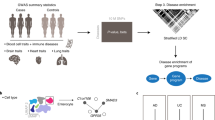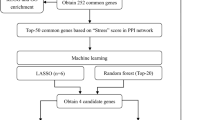Abstract
A recent genome-wide scan of nonsynonymous SNPs and ulterior validation in case-control and family analyses evidenced a susceptibility locus for type 1 diabetes (T1D) on chromosome 2q24.3. We aimed at testing the effect of this locus in other autoimmune diseases with complex genetic background, such as multiple sclerosis (MS). Four SNPs along the locus, rs13422767, rs2111485, rs1990760 and rs2068330, were genotyped using TaqMan MGB chemistry in 311 T1D and 412 MS patients and 535 ethnically matched healthy controls. The previously reported association of this locus was found for the first time in MS (rs2068330, G vs C: P=0.001; OR (95% CI)=0.73 (0.6–0.88)) and a trend for replication was observed in our Spanish diabetic cohort. Therefore, genes included in this locus – IFIH1 interferon induced helicase, GCA grancalcin or the potassium channel KCNH7 – are potential candidates implicated in the pathogenesis of these autoimmune diseases, although strong linkage disequilibrium in the region hampered further localization of the etiologic gene.
Similar content being viewed by others
Log in or create a free account to read this content
Gain free access to this article, as well as selected content from this journal and more on nature.com
or
References
Fujinami RS, von Herrath MG, Christen U, Whitton JL : Molecular mimicry, bystander activation, or viral persistence: infections and autoimmune disease. Clin Microbiol Rev 2006; 19: 80–94.
Janeway Jr CA, Medzhitov R : Innate immune recognition. Annu Rev Immunol 2002; 20: 197–216.
Smyth DJ, Cooper JD, Bailey R et al: A genome-wide association study of nonsynonymous SNPs identifies a type 1 diabetes locus in the interferon-induced helicase (IFIH1) region. Nat Genet 2006; 38: 617–619.
Gutman GA, Chandy KG, Grissmer S et al: International Union of Pharmacology. LIII. Nomenclature and molecular relationships of voltage-gated potassium channels. Pharmacol Rev 2005; 57: 473–508.
Furlan F, Guasti L, Avossa D et al: Interneurons transiently express the ERG K+ channels during development of mouse spinal networks in vitro. Neuroscience 2005; 135: 1179–1192.
Guasti L, Cilia E, Crociani O et al: Expression pattern of the ether-a-go-go-related (ERG) family proteins in the adult mouse central nervous system: evidence for coassembly of different subunits. J Comp Neurol 2005; 491: 157–174.
Liu F, Shinomiya H, Kirikae T, Hirata H, Asano Y : Characterization of murine grancalcin specifically expressed in leukocytes and its possible role in host defense against bacterial infection. Biosci Biotechnol Biochem 2004; 68: 894–902.
Sutherland A, Davies J, Owen CJ et al: Genomic polymorphism at the interferon-induced helicase (IFIH1) locus contributes to Graves' disease susceptibility. J Clin Endocrinol Metab 2007; 92: 3338–3341.e-pub 2007 May 3329.
Poser CM, Paty DW, Scheinberg L et al: New diagnostic criteria for multiple sclerosis: guidelines for research protocols. Ann Neurol 1983; 13: 227–231.
Excoffier L, Slatkin M : Maximum-likelihood estimation of molecular haplotype frequencies in a diploid population. Mol Biol Evol 1995; 12: 921–927.
Law AJ, Kleinman JE, Weinberger DR, Weickert CS : Disease-associated intronic variants in the ErbB4 gene are related to altered ErbB4 splice-variant expression in the brain in schizophrenia. Hum Mol Genet 2007; 16: 129–141.
Kimchi-Sarfaty C, Oh JM, Kim IW et al: A ‘silent’ polymorphism in the MDR1 gene changes substrate specificity. Science 2007; 315: 525–528.
Weets I, Kaufman L, Van der Auwera B et al: Seasonality in clinical onset of type 1 diabetes in belgian patients above the age of 10 is restricted to HLA-DQ2/DQ8-negative males, which explains the male to female excess in incidence. Diabetologia 2004; 47: 614–621.
Kato H, Takeuchi O, Sato S et al: Differential roles of MDA5 and RIG-I helicases in the recognition of RNA viruses. Nature 2006; 441: 101–105.
Kriesel JD, White A, Hayden FG, Spruance SL, Petajan J : Multiple sclerosis attacks are associated with picornavirus infections. Mult Scler 2004; 10: 145–148.
Olson JK, Ercolini AM, Miller SD : A virus-induced molecular mimicry model of multiple sclerosis. Curr Top Microbiol Immunol 2005; 296: 39–53.
Benoist C, Mathis D : Autoimmunity provoked by infection: how good is the case for T cell epitope mimicry? Nat Immunol 2001; 2: 797–801.
Skarsvik S, Puranen J, Honkanen J et al: Decreased in vitro type 1 immune response against coxsackie virus B4 in children with type 1 diabetes. Diabetes 2006; 55: 996–1003.
Yoon JW, Jun HS : Viruses cause type 1 diabetes in animals. Ann NY Acad Sci 2006; 1079: 138–146.
Chehadeh W, Kerr-Conte J, Pattou F et al: Persistent infection of human pancreatic islets by coxsackievirus B is associated with alpha interferon synthesis in beta cells. J Virol 2000; 74: 10153–10164.
Flodstrom M, Maday A, Balakrishna D, Cleary MM, Yoshimura A, Sarvetnick N : Target cell defense prevents the development of diabetes after viral infection. Nat Immunol 2002; 3: 373–382.
Restano-Cassulini R, Korolkova YV, Diochot S et al: Species diversity and peptide toxins blocking selectivity of ether-a-go-go-related gene subfamily K+ channels in the central nervous system. Mol Pharmacol 2006; 69: 1673–1683.
Muhlbauer E, Bazwinsky I, Wolgast S, Klemenz A, Peschke E : Circadian changes of ether-a-go-go-related-gene (Erg) potassium channel transcripts in the rat pancreas and beta-cell. Cell Mol Life Sci 2007; 64: 768–780.
Nacken W, Sorg C, Kerkhoff C : The myeloid expressed EF-hand proteins display a diverse pattern of lipid raft association. FEBS Lett 2004; 572: 289–293.
Acknowledgements
We thank Carmen Martínez for her skilful technical assistance. Alfonso Martínez and Jose Luis Santiago are recipients of FIS contracts (CP04/00175 and CM05/00216, respectively). Elena Urcelay works for the ‘Fundación para la Investigación Biomédica-Hospital Clínico San Carlos’. This work was supported by grants from: FIS PI070369, FIS PI070353 and FIS PI051221.
Author information
Authors and Affiliations
Corresponding author
Rights and permissions
About this article
Cite this article
Martínez, A., Santiago, J., Cénit, M. et al. IFIH1-GCA-KCNH7 locus: influence on multiple sclerosis risk. Eur J Hum Genet 16, 861–864 (2008). https://doi.org/10.1038/ejhg.2008.16
Received:
Revised:
Accepted:
Published:
Issue date:
DOI: https://doi.org/10.1038/ejhg.2008.16
Keywords
This article is cited by
-
ROGUE: an R Shiny app for RNA sequencing analysis and biomarker discovery
BMC Bioinformatics (2023)
-
Association of CD247 (CD3ζ) gene polymorphisms with T1D and AITD in the population of northern Sweden
BMC Medical Genetics (2016)
-
The RIG-I-like helicase receptor MDA5 (IFIH1) is involved in the host defense against Candida infections
European Journal of Clinical Microbiology & Infectious Diseases (2015)
-
Genome resequencing and bioinformatic analysis of SNP containing candidate genes in the autoimmune vitiligo Smyth line chicken model
BMC Genomics (2014)
-
Genome-wide association analyses identify 13 new susceptibility loci for generalized vitiligo
Nature Genetics (2012)



